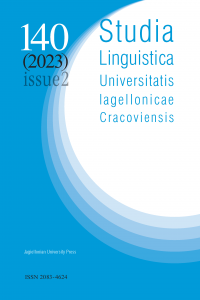BEYOND MERE FACTS: EPISTEMIC PROFILES OF CONCLUSIONS TO ENGLISH- AND POLISH-LANGUAGE LINGUISTICS ARTICLES
BEYOND MERE FACTS: EPISTEMIC PROFILES OF CONCLUSIONS TO ENGLISH- AND POLISH-LANGUAGE LINGUISTICS ARTICLES
Author(s): Krystyna WarchałSubject(s): Lexis, Semantics, Western Slavic Languages, Philology
Published by: Wydawnictwo Uniwersytetu Jagiellońskiego
Keywords: stance; epistemic modality; research articles; conclusions; rhetorical moves;
Summary/Abstract: Expressions of epistemic stance in academic discourse reflect not only the authors’ com- mitment to the truth of what is being said, but also their awareness of other members of the discourse community, the current thinking within the discipline, and the established patterns of interaction. Stance-taking is strongly embedded in culture and language, as demonstrated in numerous studies that focus on L2 academic English (e.g. Hinkel 2002; Dontcheva-Navratilova 2018; Wu and Paltridge 2021) and, less often, academic communication in various linguistic contexts (e.g. Perez-Llantada 2010). This paper pur- sues this latter line of inquiry and proposes a contrastive analysis of epistemic markers in conclusions to English- and Polish-language linguistics articles in an attempt to iden- tify their epistemic profiles. Epistemic profile refers here to a combination of two fea- tures: the epistemic modal value (Halliday 1985/1994) which is marked more frequently than others across a text or text fragment, and the concurrence of modality markers with specific rhetorical moves (Swales 1990; Yang and Allison 2003). Thus, it provides information about the value of modalization and the type of content that tends to be modalized. The analysis was based on a two-part corpus of conclusions to 400 linguistics articles, with 200 English-language articles drawn from international databases and 200 Polish-language articles published in recognized national journals. In the first stage, the frequencies of epistemic markers in the two sub-corpora were calculated (Scott 2008) and a statistical analysis was applied to determine whether the differences were signifi- cant. In the second stage, 50 concluding sections from each sub-corpus were manually annotated for rhetorical moves to determine whether epistemic markers tended to occur within specific moves. The findings show statistically significant differences in the fre- quencies of high- and low-value epistemic markers in the sub-corpora and a tendency for epistemic markers to occur within moves that offer interpretive content.
Journal: Studia Linguistica Universitatis Iagellonicae Cracoviensis
- Issue Year: 140/2023
- Issue No: 2
- Page Range: 165-189
- Page Count: 25
- Language: English

